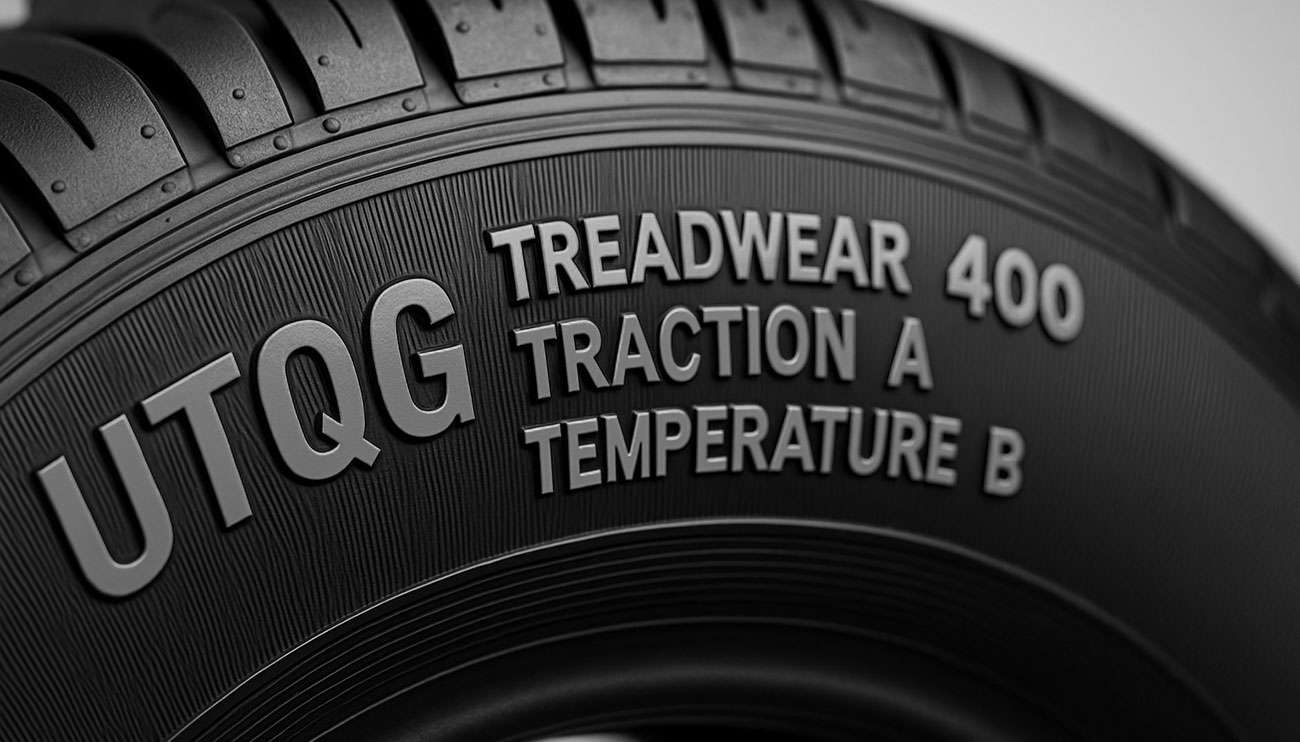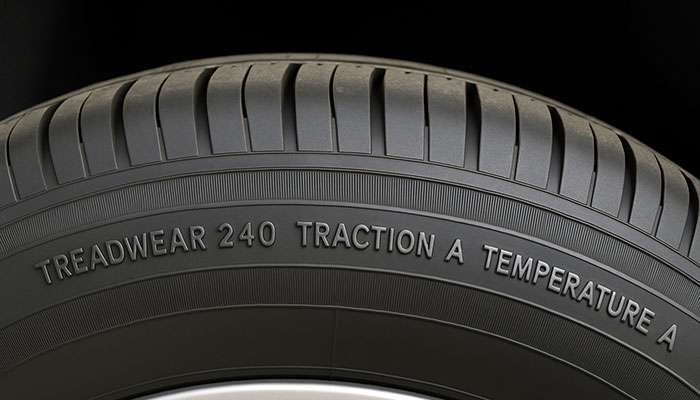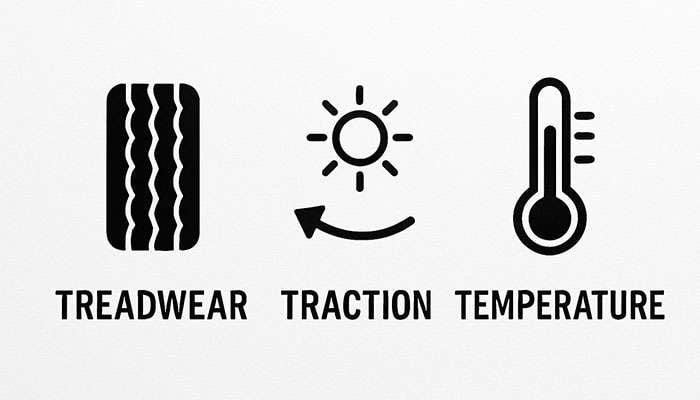
UTQG tire ratings have been helping drivers make smarter tire choices since 1978. Those three-digit numbers and letter combinations on your tire sidewalls aren't just manufacturer codes – they're a government-mandated grading system designed to help you choose the right tires for your safety and budget.
The Uniform Tire Quality Grading system came from the United States government through the Department of Transportation (DOT) and National Highway Traffic Safety Administration (NHTSA) to give consumers reliable tire comparison data. The system measures three critical factors: treadwear, traction, and temperature resistance. A tire with a treadwear rating of 400 should last twice as long as one rated 200, which gives you real information about your tire investment.
At Performance Plus Tire, we know these ratings can make the difference between a smart purchase and an expensive mistake. These numbers directly impact both your safety on the road and how much you'll spend on replacements. Our experts will break down what these often-confusing ratings actually mean so you can make the best tire decisions for your vehicle.

The UTQG rating system was created as a standardized way to compare tire performance across different brands and models. While the concept sounds straightforward, there are important limitations you should know about before making decisions based solely on these numbers.
The Department of Transportation doesn't actually conduct the UTQG tests. Tire manufacturers or third-party testing companies perform these evaluations themselves and report results to the DOT. This self-testing approach can create inconsistencies between different brands' ratings.
Each manufacturer also chooses their own baseline tire (Course Monitoring Tire) for testing. This means comparing UTQG ratings between different tire brands isn't always reliable. The ratings work best when comparing tires within the same manufacturer's lineup.
These ratings represent a tire's performance under controlled test conditions, which often don't match real-world driving. Your daily driving habits, local weather conditions, and road surfaces can significantly affect how these ratings translate to actual performance.
Several tire types don't require UTQG ratings at all. Winter tires, light truck tires with deep treads, temporary spare tires, and trailer tires are exempt from displaying these grades.
Despite these limitations, UTQG ratings still provide valuable comparison data when used correctly. Combined with manufacturer warranties and professional recommendations, these ratings can help guide your tire selection process.

Each UTQG component tells you something different about how your tires will perform on the road. Understanding what these numbers and letters actually measure helps you choose tires that match your driving needs.
Treadwear ratings range from 100 to 1000 and indicate relative durability between tire models. During testing, tires run for 7,200 miles on a specific test track in West Texas. A tire graded 200 should theoretically last twice as long as one graded 100.
Here's something important: manufacturers can under-report treadwear grades but never inflate them. This means you might get more mileage than expected, but the numbers give you a reliable baseline for comparisons.
Traction grades use letters (AA, A, B, C) to measure wet stopping ability. The test pulls tires at 40mph over wet surfaces while briefly locking the brakes to measure friction. AA-rated tires provide superior wet traction compared to C-rated options.
Keep in mind this test only measures straight-line wet braking. It doesn't evaluate cornering, dry performance, or hydroplaning resistance. For complete wet weather safety, you'll want to consider other factors beyond just the traction grade.
Temperature grades (A, B, C) show how well tires handle heat buildup. Grade A tires withstand speeds above 115mph, B handles 100-115mph, while C manages 85-100mph. Testing involves running inflated tires against high-speed test drums.
Even if you don't drive at these speeds regularly, better heat resistance often means improved durability and safety margins during extended highway driving.
Get your tires today with full UTQG Specifications to make informed decisions based on complete data rather than guesswork about tire performance.
UTQG ratings provide standardized measurements, but the real story happens on your daily commute, not in controlled laboratory conditions. These test environments rarely match the stop-and-go traffic, temperature extremes, and varied road surfaces you actually drive on.
UTQG treadwear numbers offer relative comparisons rather than mileage guarantees. A tire rated 400 should theoretically last four times longer than one rated 100, but your actual results depend on driving habits, road conditions, climate, and maintenance practices. Aggressive acceleration, hard braking, and poor alignment can cut tire life significantly regardless of ratings.
Here's something interesting: manufacturers can legally understate their treadwear grades for competitive reasons. Many tire experts now recommend focusing on manufacturer mileage warranties instead of UTQG numbers. These warranties give you actual mile expectations and often include pro-rated coverage if tires wear out early.
Safety considerations matter more than any rating. Worn treads reduce your grip and increase puncture risk. Replace tires when tread depth reaches 2/32 of an inch, no matter what the sidewall says. Don't forget that tires age even with light use – most become unsafe after 6-10 years due to rubber deterioration.
Keep in mind that winter tires, trailer tires, and heavy truck tires don't require UTQG ratings at all. When selecting replacements, consider driving conditions, vehicle type, and your budget alongside these ratings. Get your tires today with full UTQG Specifications from Performance Plus Tire for complete transparency about what you're purchasing.
UTQG ratings give you a starting point for tire comparisons, but they're just one piece of the puzzle. These standardized numbers help you compare options within the same brand's lineup, though real-world performance depends heavily on your specific driving conditions and habits.
Remember that manufacturers test their own products using different baseline standards. This means a 400 treadwear rating from one brand might not directly compare to another brand's 400 rating. Manufacturer mileage warranties often provide more reliable expectations than UTQG numbers alone.
Your safety depends on proper tire maintenance regardless of any rating. Replace tires when tread depth reaches 2/32 of an inch, and don't forget that tires age even with minimal use. Most tires should be replaced after 6-10 years regardless of tread condition.
When shopping for your next set of tires, use UTQG ratings as a comparison tool, but also consider your driving needs, local weather conditions, and budget. The best tire choice combines understanding these ratings with practical factors like warranty coverage and professional recommendations.
Ready to find the right tires for your vehicle? Our tire specialists can help you decode the ratings and match you with tires that deliver the performance and safety you need for your specific driving situation.
Understanding UTQG tire ratings helps you make safer, more informed tire purchasing decisions by decoding the standardized system that evaluates treadwear, traction, and temperature resistance.
• UTQG ratings provide comparative data, not absolute guarantees - A 400 treadwear rating should last twice as long as 200, but real-world conditions vary significantly from controlled tests.
• Traction grades (AA, A, B, C) measure wet braking performance only - These ratings don't evaluate cornering, dry performance, or hydroplaning resistance capabilities.
• Temperature grades (A, B, C) indicate heat resistance at specific speeds - Grade A handles 115+ mph, B manages 100-115 mph, while C covers 85-100 mph safely.
• Manufacturer warranties often provide more practical expectations than UTQG numbers - Since manufacturers self-test and can understate ratings, mileage warranties offer clearer longevity guidance.
• Replace tires when tread reaches 2/32 inch regardless of ratings - Safety depends on actual tread depth and tire age (6-10 years maximum), not just UTQG specifications.
Remember that UTQG ratings work best for comparing tires within the same brand's lineup. Combine these ratings with professional recommendations, your specific driving needs, and manufacturer warranties for the most comprehensive tire selection approach.
A higher UTQG treadwear rating generally indicates better durability. For example, a tire rated 400 should theoretically last twice as long as one rated 200. However, actual longevity depends on various factors like driving habits and road conditions.
UTQG traction grades (AA, A, B, C) measure a tire's wet stopping ability. AA-rated tires offer superior wet traction compared to C-rated options. However, these ratings don't evaluate cornering, dry performance, or hydroplaning resistance.
Temperature grades (A, B, C) reflect a tire's heat resistance capabilities. Grade A tires can withstand speeds above 115mph, B handles 100-115mph, and C manages 85-100mph. This is crucial for maintaining tire integrity at high speeds.
No, UTQG ratings are not absolute indicators. They provide comparative data rather than guaranteed performance. Real-world conditions often differ from controlled tests, and manufacturers can legally understate treadwear grades for marketing purposes.
Tires should be replaced when the tread is worn to 2/32 of an inch, regardless of UTQG ratings. Additionally, tires can age even when not used frequently, making them prone to failure after 6-10 years. Regular inspections and maintenance are crucial for safety.